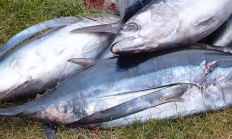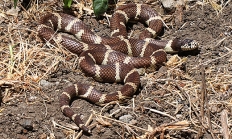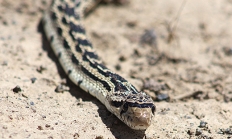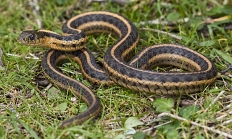Search myodfw.com
Features: Before spawning, sockeye salmon are silvery on their sides, white on their bellies, and dark blue on their backs. When spawning, their heads turn green with black on the snout and upper jaw, and their bodies turn red. They can be 24- to 33- inches long and weight between 5 and 15 pounds. Habitat: Many sockeye populations require a lake for part of their life cycle. Spawning may occur along lake shorelines or in stream gravels, but fry usually migrate to lake environments soon after emergence and occupy this habitat during their stay in fresh water. Technique: Sockeye salmon


Features: These fish are light silvery-white, dark on top, and have up to 8 dark, broken stripes running along the sides of their bodies. They are typically less than 10 lbs but can grow to 22 lbs. They have two dorsal fins, the front one with eight or nine spines and the rear one with one spine and 13 or 14 soft rays. Habitat: Hybrid bass were originally stocked in Tenmile Lakes on the south coast and in Ana Reservoir in Lake County. They have since been introduced into Thompson Reservoir, also in Lake County. The only established population is

Features: Largemouth bass are greenish on the back and sides with a white belly and usually a dark horizontal stripe along the side. They are distinguished from their close cousin, the smallmouth, by a large mouth with the upper jaw extending behind the eye. Largemouth bass in Oregon can exceed 25 inches in length and a weight of 12 pounds. Habitats: Their preferred habitats are shallow ponds and lakes, or the backwater sloughs of rivers where aquatic plants or submerged logs and brush provide abundant cover. Largemouth bass begin life feeding on zooplankton (tiny crustaceans), but soon switch to insects

Features: Smallmouth bass are golden green to bronze with dark vertical bars and blotches on the side. The upper jaw does not extend beyond the eye. In some locations, it has a red eye. Somewhat smaller than the largemouth, smallmouth bass in Oregon may reach 23-inches and exceed 7 pounds. Habitat: Smallmouth bass are adapted to flowing waters and do well in warm streams with deep holes and rocky ledges. They also prefer lakes and reservoirs with rocky shorelines and limited vegetation. Adult smallmouth feed mostly on fish and crayfish. Technique: Much of what was written about largemouth bass also

Features: They are dark olive on the tops of their bodies, silver on the sides, and white underneath, with 6-9 black stripes running horizontally from behind their heads to their tails. Habitat: Striped bass spend most of their time in fresh water, with occasional and unpredictable trips to the sea. Technique: In the spring and fall stripers are likely to be closer to the surface. During this time bait, such as dead minnows or night crawlers, will entice the fish to bite. During summer, the bass go deeper to escape the heat. This is the time to use flashy bait.

Features: These fish have dark blue backs, silver sides and bellies, and very long pectoral (side) fins. Albacore caught off the Pacific Coast are generally 21 to 30 inches long with the largest fish running about 35 pounds. Habitat: Tuna are pelagic species, meaning they spend their lives in the open ocean. Albacore generally show up 15-200 miles or more off the Pacific Coast in mid-July and stick around through September. Albacore are usually found where surface water temperatures are at least 59 degrees Fahrenheit and the water has a distinct clear blue color (this is where chlorophyll levels are

Features: Plankton eaters, the American shad is the biggest of the herring species and averages 3 to 5 pounds. They are silver on the sides, and green to blue on top, with green shading on their fins. Habitat: Like other anadromous fish species, they spend most of their lives at sea and return to fresh water to spawn. Females release free-floating eggs that will be fertilized by later-arriving male, called buck shad, in a spawning frenzy. Eggs hatch in eight days and fry spend four to five years in salt water before returning to spawn. Shad often survive to spawn

Features: These blue-green, silvery or light brown fish are a schooling fish and an important food source for larger fishes, sea birds and marine mammals. Habitat: Anchovy are frequently offshore, but can be caught inshore in harbors and large estuaries during spawning. Technique: Anchovy are usually targeted in bays with multiple-hook herring jigs.

Features: Cabezon are a dark green to dark brown with mottling along their sides and with smooth, scaleless skin. The largest cabezon caught was over 20 pounds, but on average they weigh approximately 4 pounds. Habitat: Cabezon live around kelp beds and rocky headlands over hard bottoms. Technique: Cabezon are best caught using rubber tailed jigs tipped with bait. Make sure you are fishing within just a foot or two of the bottom as Cabezon like to hold tight to cover. CAUTION: While Cabezon meat can be safely consumed, its roe is poisonous to humans. Photo credit: Brandon Ford


This snake is most common in thick vegetation along water bodies, but ranges into farmland, chaparral, and deciduous and mixed coniferous woodlands in the Rogue and Umpqua river valleys of southwestern Oregon. Common kingsnakes usually feed on other snakes, but have been known to take small turtles, birds and their eggs, frogs, lizards, reptile eggs, and some small mammals. Photo by Alan Schmierer, Flickr

This species is found in pine forests, oak woodlands, and in chaparral of southwestern Oregon valleys. It is usually found in, under, or near rotting logs in open wooded areas near streams. The California mountain kingsnake preys upon snakes, lizards, birds and their eggs, and some small mammals. It is an Oregon Conservation Strategy Species in these ecoregions: Coast Range, Columbia Plateau, East Cascades, Klamath Mountains, and West Cascades. Photo by William Grenfell, Flickr

In the Northwest, this snake is found in grasslands, sagebrush flats, rocky stream courses, and canyon bottoms. Elsewhere it also frequents juniper and pine-oak woodlands. In southwestern Oregon, it is found in dry bushy areas close to rocks. Young striped whipsnakes feed primarily on lizards and insects. Adults also take snakes, small mammals, young birds, and insects. Photo by Bryn Hamilton, Flickr

The gopher snake occurs in a wide variety of habitats, from deserts and grasslands to woodlands and open forests. It frequents agricultural regions, especially where there is brushy cover such as fence rows. Diet varies according to size, with young eating insects, lizards, rodents, and birds and their eggs. Adults can take larger prey, occasionally as large as rabbits. Photo by Simon Wray, ODFW

The Western ground snake is found in arid desert scrub vegetation with sandy soil, usually under surface objects or in areas with some surface moisture, such as the edges of washes. This snake feeds on small arthropods such as spiders, scorpions, centipedes, crickets, and grasshoppers. It also takes insect larvae. Photo by Peter Paplanus, Flickr

This highly aquatic snake is found in wet meadows, riparian areas, marshes, and moist forests near rivers, streams, lakes and ponds. It requires streams with thick riparian vegetation for escape and exposed boulders for basking. The Pacific coast aquatic garter snake takes aquatic prey such as small fish and fish eggs, salamanders, tadpoles, frogs, toads, earthworms, and leeches. Photo by Simon Wray, ODFW

This species is found in a variety of habitats. To make matters more confusing, four subspecies are found in Oregon, each of which has somewhat different habitat preferences. All can be found in moist areas such as marshes and lake or stream margins, but two may occur some distance from water. The diet varies among subspecies; the more aquatic forms feed on fish, frogs, tadpoles, and leeches, which are eaten in the water. Terrestrial forms take frogs and toads, but also lizards, small mammals, salamanders and slugs. Photo by David Bronson, ODFW

This snake is found in meadows and at the edges of clearings in forests. It prefers areas with dense vegetation but, when basking, can be found in open areas or on talus slopes. It occurs in wooded areas on the floor of the Willamette Valley and has been found in the Rogue Valley. This garter snake is commonly found in suburban areas and city parks. The Northwestern garter snake feeds mainly on slugs and earthworms, but also takes insects, small salamanders, frogs, fish, small mammals, and possibly nestlings of ground nesting birds. Photo by J. Maughn, Flickr

Much variability in coloration exists in the common garter snake but the best identifying characteristic is a stripe down the middle of the snake's back. While the common garter snake frequents wet meadows and forest edges, it occurs in a variety of habitats far from water, including open valleys and moist coniferous forest. Smaller snakes eat earthworms, but adults feed on a variety of vertebrate prey, including frogs, toads, salamanders, birds, fish, reptiles, and small mammals. Invertebrates, including slugs and leeches, are also eaten. Photo by Dave Budeau, ODFW

